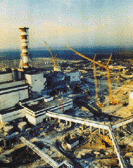 | Safety Improvements at the Chornobyl Shelter |
 The 1986 accident destroyed the Chornobyl Unit 4 reactor building |
On April 26, 1986, the most serious accident in the history of nuclear power occurred at Ukraine's Chornobyl nuclear power plant. As a result of this accident, the reactor core-- containing about 200 tons of nuclear fuel--was destroyed. Large amounts of radioactive dust, gases, and debris--an estimated 50 megacuries--rose into the atmosphere. The heat from the core sent some of this material as high as 10 km (6 miles), to be transported in regional and global weather patterns. The material contaminated more than 155,000 km2 (60,000 square miles) of Ukraine, Belarus, and Russia. Smaller amounts of radioactive material spread over eastern Europe and Scandinavia, and fallout was detected in the United States. During the two weeks after the explosion, workers dropped 5,000 tons of boron compounds, dolomite, sand, clay, and lead out of helicopters to limit the release of radioactive materials.
The Unstable Shelter
 Fig. 1 - The 20-story, 300,000-ton concrete and steel shelter was constructed hastily to contain some 200 tons of irradiated fuel. The ventilation stack is shown on the left. |
Built in just seven months, under difficult and hazardous conditions, the shelter has cracks and holes. Birds can enter and then spread contamination. More hazardous is the water from rain, snow, cleanup work, and condensation that has collected inside. The water not only causes structural corrosion but is turning some of the melted, lava-like fuel into radioactive dust. The dust endangers workers and can escape through the shelter's holes.
The water also raises the risk of a criticality accident inside the shelter by moderating the neutrons. Monitoring has shown occasional increases in the neutron count rate, suggesting that uncontrolled nuclear chain-reactions might be taking place. Improved monitors will determine whether this is the case.
The shelter itself poses risks. Built partly on the remains of the ruined reactor building, it is unstable and could collapse, injuring workers and spreading radioactive dust.
| The 1986 Disaster/The Unstable
Shelter | Closure of the Chornobyl
Plant | |